
| Palaeos |  |
Primates |
| Vertebrates | Hominoidea |
| Page Back | Unit Home | Unit Dendrogram | Unit References | Taxon Index | Page Next |
| Unit Back | Vertebrates Home | Vertebrate References | Vertebrate Dendrograms | Glossary | Unit Next |
|
Abbreviated Dendrogram
ARCHONTA | PRIMATES |--Strepsirhini `--Haplorhini |--Tarsiiformes `--Anthropoidea |--Platyrrhini `--Hominoidea |--Proconsul `--+--Kenyapithecus `--+--Hylobatidae `--Hominidae |--Dryopithecus `--+--Pierolapithecus `--+--Ponginae `--+--Ramapithecus `--Homininae |
Contents
Overview |
Taxa on This Page
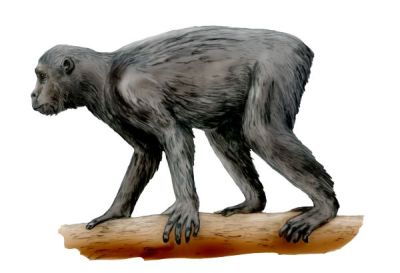 Life reconstruction of the Miocene East African basal hominoid Proconsul. Artwork by Nobu Tamura. Wikipedia,GNU Free Documentation/Creative Commons Attribution Share Alike |
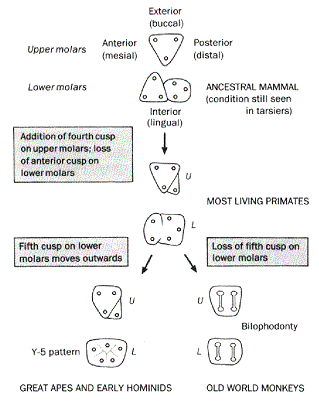 Hominoidea :
apes. Gorilla, Homo, Hylobates, Pan, Pongo, Proconsul
Hominoidea :
apes. Gorilla, Homo, Hylobates, Pan, Pongo, Proconsul
Range: from the Late Oligocene or Early Miocene. cosmopolitan.
Phylogeny: Catarrhini : Cercopithecidae + * : Proconsul + (Morotopithecus + (Kenyapithecus + (Hylobatidae + Hominidae)))
Characters: large body size; $ suture between maxilla & premaxilla meets nasal closer to the rostral end of the nasal than to the orbit [R99]; $ nasal quite flat between orbits, rather than forming parabolic ridge (reversed in Homo) [R99]; large frontal sinus; ectotympanic ring is drawn out to form an external bony auditory meatus (plesiomorphic); large brain size; $ width of palate at level of canines greater than width at P2 [R99]; dental formula 2/2, 1/1, 2/2, 3/3; incisors enlarged; "Y-5" molar pattern (see diagram); thorax broad; short thoracic region; body relatively shallow, front to back; ischial callosities absent (reversal); tail reduced or absent; arms usually longer than legs; scapulae dorsal rather than lateral; clavicles elongated; all forearm joints highly mobile; olecranon short; ulnar styloid process short; arms & fingers frequently long; $ head of astragalus (talus) narrow [R99]; bipedality & upright carriage common; young carried ventrally; almost all terrestrial (except orangutan) or brachiate in trees;
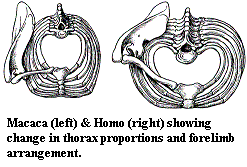 Note:
as Rae notes, his results suggest that changes in the face came before changes
in locomotion.
Note:
as Rae notes, his results suggest that changes in the face came before changes
in locomotion.
Image: (right) evolution of "Y-5" molar pattern from Family Cercopithecidae Superfamily Cercopithecoidea Family .... (right) thoracic regions of macaque & man, showing change in proportions and arrangement of forelimb girdle from Thomas Geissmann's Gibbon Research Lab.- Die Gibbons ( .... (lower right) the eminent hominoid, M. Alan Kazlev.
Links:
 Family Cercopithecidae Superfamily Cercopithecoidea Family ...;
Hominoidea; Mosaic Evolution in the Origin of the Hominoidea;
Ökologie fossiler und rezenter Hominoidea
(German); Hominoidea;
hominoid
(with nice image of Proconsul); A New Origin for Hominoidea-;
Thomas Geissmann's Gibbon Research Lab.- Die Gibbons ( ...
(also in German. Best on the Web); Lecture 21 - Hominoidea;
Link Voyager Archaeology Directory;
Evolucao e Filogenia
(Portuguese); Pun 2.3.htm;
Altweltaffen
(German); John A. Finarelli's Research Page;
The Primates- Humans.
Family Cercopithecidae Superfamily Cercopithecoidea Family ...;
Hominoidea; Mosaic Evolution in the Origin of the Hominoidea;
Ökologie fossiler und rezenter Hominoidea
(German); Hominoidea;
hominoid
(with nice image of Proconsul); A New Origin for Hominoidea-;
Thomas Geissmann's Gibbon Research Lab.- Die Gibbons ( ...
(also in German. Best on the Web); Lecture 21 - Hominoidea;
Link Voyager Archaeology Directory;
Evolucao e Filogenia
(Portuguese); Pun 2.3.htm;
Altweltaffen
(German); John A. Finarelli's Research Page;
The Primates- Humans.
References: Rae (1999) [R99]. ATW021110.
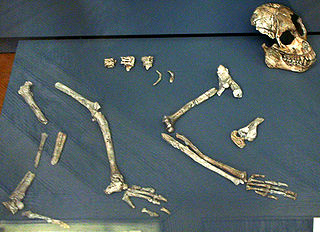
Proconsul : Hopwood 1933 P. africanus Hopwood 1933 (type), P. nyanzae Clark & Leakey 1950, P. major Clark & Leakey 1950 [=Dryopithecus major], P. heseloni
Synonyms: Xenopithecus
Range: Early Miocene of East Africa (Kenya and Uganda)
Phylogeny: Hominoidea : (Morotopithecus + (Kenyapithecus + (Hylobatidae + Hominidae))) + *
Comments: Proconsul was the first of the fossil apes to be discovered. Prior to that time, a number of fossil hominids (=homina) were known, but no fossil apes. Since then there have been a flurry of Kenyapithecii, Ramapithecii, Shivapithecii, and more obscure and less well known types. Many of these are known from fragmentary material, making phylogenetic placement difficult. Unlike the other pithecii which would eclipse it on the pjhylogenetic tree, Proconsul ("before Consul") shared the stem of name with the title of the provincial governor of ancient Rome. The reason was that at the time Consul was the name given to several popular performing circus chimpanzees, although cladistically speaking one could equally place Procunsel before Roman governors (both being members of the Hominae line).
Either a basal hominoid or a stem-hominoid, Proconsul had a mixture of Old World monkey and ape characteristics. Monkey-like features include pronograde postures, indicated by a long flexible back, curved metacarpals, and an above-branch arboreal quadrupedal positional repertoire. The primary feature linking Proconsul with extant apes is its lack of a tail; other "ape-like" features include its enhanced grasping capabilities, stabilized elbow joint and facial structure. Unlike modern apes, Proconsul was not a brachiator (it did not get about by swingings from tree branches) Four species have been classified to date: P. africanus, P. heseloni, P. major and P. nyanzae differ mainly in body size. Environmental reconstructions for the Early Miocene Proconsul sites are still tentative and range from forested environments to more open, arid grasslands. Rangwapithecus may be a related or synonymous genus (or subgenus) . Wikipedia
Graphic - Proconsul nyanzae, Muséum national d'histoire naturelle, Paris.. Photo by FunkMonk Wikipedia, GNU Free Documentation/Creative Commons Attribution Share Alike
Morotopithecus : M. bishopi Gebo et al., 1997
Phylogeny: Hominoidea : Proconsul + ((Kenyapithecus + (Hylobatidae + Hominidae)) + *)
Range: Early Miocene of Moroto, Uganda
Comments: According to Filler 2007 (and link) the fiist ape to walk upright (gorillas and chimps secondarily reverting to knuklewalking) Morphological parsimony analyses show Morotopithecus to be more derived than Proconsul, Afropithecus, and Kenyapithecus, but less derived than Oreopithecus, Sivapithecus, and Dryopithecus. Stratocladistic analysis (followed here) places it between Proconsul and Kenyapithecus. MAK111129
Link Wikipedia
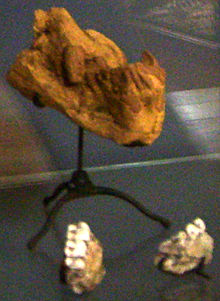
Kenyapithecus : Leakey 1962 K. wickeri Leakey 1962 (type species), K. africanus (Clark & Leakey 1951)
Phylogeny: Hominoidea : Proconsul + (Morotopithecus + ((Hylobatidae + Hominidae) + *))
Synonyms: Sivapithecus africanus
Range: Miocene of Kenya
Comments: Kenyapithecus teeth and jaws were adapted to feeding on hard objects, as shown by thicker molar enamel, large mandible, large premolars and upper incisors, similar to those seen in living New World monkies (family Pitheciidae) (Fleagle1999). It also possessed macaque-like limbs adapted for a knuckle-walking mode of semi-terrestrial locomotion (McCrossin et al 1998) This could show that as hominins evolved, they passed through a knuckle-walking phase. Impressed by Kenyapithecus's modern-looking teeth, Leakey declared Kenyapithecus to be "a very early ancestor of man himself." (Zimmer 1999) Wikipedia. According to John A. Finarelli, morphological Cladistic analysis of the data support a postcranially primitive "parahominoid" clade, comprised of early to middle Miocene hominoids from eastern Africa (Afropothecus, Kenyapithecus, etc), and a postcranially derived "euhominoid" clade delineated by the derived postcranial morphology witnessed in the early Miocene hominoid Morotopithecus, and including also Dyopithecus, Ponginae, and Hominae. However, incorporating the stratigraphic data for a stratocladistic analysis reveals a single most parsimonious phylogenetic tree and erases the "parahominoid"/"euhominoid" distinction, where East African taxa are interpreted to form a continuous hominoid lineage through the early Miocene. In both phylogenies however Kenyapithecus is intermediate betaween Procunsal and the Hylobatid-Hominid split.
Graphics Kenyapithecus wickeri, Muséum national d'histoire naturelle, Paris Wikipedia
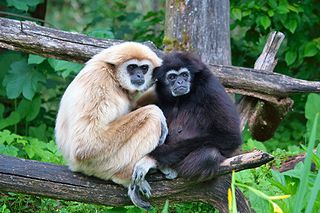
Hylobatidae : Gibbons - Hylobates, Hoolock, Nomascus, Symphalangus, Bunopithecus
Range: Quaternary of Asia
Phylogeny: Hominoidea : Proconsul + (Morotopithecus + (Kenyapithecus + (Hominidae + *)))
Habitat: tropical and subtropical rainforests from northeast India to Indonesia and north to southern China, including the islands of Sumatra, Borneo and Java.
Comments: Also called the lesser apes, gibbons differ from great apes (chimpanzees, bonobos, gorillas, orangutans and humans) in being smaller, exhibiting low sexual dimorphism, in not making nests, and in certain anatomical details in which they superficially more closely resemble monkeys than great apes do. Gibbons also display pair-bonding, unlike most of the great apes. Gibbons are masters of their primary mode of locomotion, brachiation, swinging from branch to branch for distances of up to 15 m, at speeds as high as 56 km/h. They can also make leaps of up to 8 m, and walk bipedally with their arms raised for balance. Gibbon species include the siamang, the white-handed or lar gibbon, and the hoolock gibbons. The siamang, which is the largest of the sixteen species, is distinguished by having two fingers on each foot stuck together, hence the generic and species names Symphalangus and syndactylus. The only known fossil form to date is Bunopithecus sericus, known from the Middle Pleistocene of Sichuan, China. Molecular sdating indicates that extant genera diverged around 8 million years ago (late Miocene). Wikipedia
Graphic - A pair of Lar Gibbons (Hylobates lar). Photo by Matthias Kabel Wikipedia, GNU Free Documentation/Creative Commons Attribution Share Alike
Range: from the Late Oligocene or Early Miocene. cosmopolitan.
Phylogeny: Hominoidea : Proconsul + (Morotopithecus + (Kenyapithecus + (Hylobatidae + * : Dryopithecus + (Pierolapithecus + (Ponginae + Homininae)))))
Comments: Largest of the primates; include orangutans, gorillas, common chimpanzees, bonobos, humans, and associated neogene genera and species. All extant the great apes are highly intelligent, use at least simple tools, such as modified twigs or branches (as do corvids ,on an equivalent cognitive level), have rich emotional lives (like all higher animals (Bekoff2007)), and at least the rudiments of cultural development. It can be assumed that these traits are common to the group, and shared by fossil species. In the genus Homo, tool use (technology), language, and culture are developed to an exceptional degree. And although pre-scientific literalist religions have perpetuated the error that humans have a privelaged status apart from animals, it is now known that behaviorally and psychologically as well as genetically and physiologically humans and the other great apes share many characteristics in common, including capacity for human langauge, incidentally also present in birds (Pepperberg 2002). On extending human rights to our closest biological relatives,, see The Great Ape Project: Equality beyond humanity. (Singer & Cavalieri, 1993.)
Note on nomenclature: The current, cladistic (phylogenetic)-based family Hominidae is probably equivalent to the old Linnaean-evolutionary superfamily Hominoidea, as in the past the great apes were included in the Pongidae and humans + australopithecines in the Hominidae. This is however an anthropocentric distinction, as genetically there is as much distinction between humans and chimps and gorillas as there are between the latter two and orang utangs. MAK120710
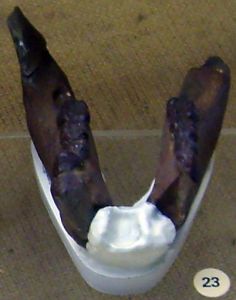
Dryopithecus : D. fontani Lartet 1856 (type species), D. brancoi, D. laietanus [=Hispanopithecus laietanus; incl. Sivapithecus occidentalis], D. sivalensis
Range: late Miocene of Eastern Africa and Eurasia (France, Hungary, Spain, and China.
Phylogeny: Hominidae : (Pierolapithecus + (Ponginae + Homininae)) + *
Comments: Dryopithecus, like the similar but more derived Sivapithecus, was suspensory, had a large brain, and a delayed development, but, unlike the former, it had a gracile jaw with thinly enameled molars and suspensory forelimbs; Begun (2004) notes that the similarities and differences between them provides insight into the timing and paleogeography of hominid origins and the phylogenetic divide between Asian and Afro-European great apes. Dryopithecus was about 60 centimetres in body length, and more closely resembled a monkey than a modern ape. The structure of its limbs and wrists show that it walked in a similar way to modern chimpanzees, but that it used the flat of its hands, like a monkey, rather than knuckle-walking, like modern apes. Its face exhibited klinorhynchy, with its face being tilted downwards in profile. It likely spent most of its life in trees, and was probably a brachiator, similar to modern orangutans and gibbons. Its molars had relatively little enamel, suggesting that it ate soft leaves and fruit, an ideal food for a tree-dwelling animal. The five-cusp and juvenile fissure pattern of its molar teeth, known as the Y-5 arrangement, is typical of hominoids in general. - Wikipedia MAK111129
Graphics Dryopithecus fontani jaw in front view at the Geological Museum, Copenhagen , Wikipedia
Pierolapithecus : P. catalaunicus Moyà-Solà, Köhler et al. 2004
Horizon: Miocene of Hostalets de Pierola, Catalonia
Phylogeny: Hominidae : Dryopithecus + ((Ponginae + Homininae) + *)
Comments: believed to be a common ancestor, or close to it, of humans and the other great apes. Adaptations for tree climbing shared by the great apes include a wide, flat ribcage, a stiff lower spine, flexible wrists, and shoulder blades that lay along its back. But it also posseses more primitive, monkeylike features, however, such as a sloped face and short fingers and toes. Its location in Spain is controversial, since all existing great ape species live in either Southeast Asia or Africa. However, the Mediterranean Sea expanded and contracted frequently in the past, permitting the dispersal of life between Africa and Europe and the Pierolapithecus could have lived on both continents. - Wikipedia, Moyà-Solà et al 2004 MAK111129
| Page Back | Unit Home | Page Top | Page Next |
checked ATW040213, page MAK120708